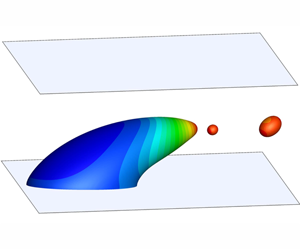Article contents
Modelling a surfactant-covered droplet on a solid surface in three-dimensional shear flow
Published online by Cambridge University Press: 18 June 2020
Abstract

A surfactant-covered droplet on a solid surface subject to a three-dimensional shear flow is studied using a lattice-Boltzmann and finite-difference hybrid method, which allows for the surfactant concentration beyond the critical micelle concentration. We first focus on low values of the effective capillary number ( $Ca_{e}$) and study the effect of
$Ca_{e}$) and study the effect of  $Ca_{e}$, viscosity ratio (
$Ca_{e}$, viscosity ratio ( $\unicode[STIX]{x1D706}$) and surfactant coverage on the droplet behaviour. Results show that at low
$\unicode[STIX]{x1D706}$) and surfactant coverage on the droplet behaviour. Results show that at low  $Ca_{e}$ the droplet eventually reaches steady deformation and a constant moving velocity
$Ca_{e}$ the droplet eventually reaches steady deformation and a constant moving velocity  $u_{d}$. The presence of surfactants not only increases droplet deformation but also promotes droplet motion. For each
$u_{d}$. The presence of surfactants not only increases droplet deformation but also promotes droplet motion. For each  $\unicode[STIX]{x1D706}$, a linear relationship is found between contact-line capillary number and
$\unicode[STIX]{x1D706}$, a linear relationship is found between contact-line capillary number and  $Ca_{e}$, but not between wall stress and
$Ca_{e}$, but not between wall stress and  $u_{d}$ due to Marangoni effects. As
$u_{d}$ due to Marangoni effects. As  $\unicode[STIX]{x1D706}$ increases,
$\unicode[STIX]{x1D706}$ increases,  $u_{d}$ decreases monotonically, but the deformation first increases and then decreases for each
$u_{d}$ decreases monotonically, but the deformation first increases and then decreases for each  $Ca_{e}$. Moreover, increasing surfactant coverage enhances droplet deformation and motion, although the surfactant distribution becomes less non-uniform. We then increase
$Ca_{e}$. Moreover, increasing surfactant coverage enhances droplet deformation and motion, although the surfactant distribution becomes less non-uniform. We then increase  $Ca_{e}$ and study droplet breakup for varying
$Ca_{e}$ and study droplet breakup for varying  $\unicode[STIX]{x1D706}$, where the role of surfactants on the critical
$\unicode[STIX]{x1D706}$, where the role of surfactants on the critical  $Ca_{e}$ (
$Ca_{e}$ ( $Ca_{e,c}$) of droplet breakup is identified by comparing with the clean case. As in the clean case,
$Ca_{e,c}$) of droplet breakup is identified by comparing with the clean case. As in the clean case,  $Ca_{e,c}$ first decreases and then increases with increasing
$Ca_{e,c}$ first decreases and then increases with increasing  $\unicode[STIX]{x1D706}$, but its minima occurs at
$\unicode[STIX]{x1D706}$, but its minima occurs at  $\unicode[STIX]{x1D706}=0.5$ instead of
$\unicode[STIX]{x1D706}=0.5$ instead of  $\unicode[STIX]{x1D706}=1$ in the clean case. The presence of surfactants always decreases
$\unicode[STIX]{x1D706}=1$ in the clean case. The presence of surfactants always decreases  $Ca_{e,c}$, and its effect is more pronounced at low
$Ca_{e,c}$, and its effect is more pronounced at low  $\unicode[STIX]{x1D706}$. Moreover, a decreasing viscosity ratio is found to favour ternary breakup in both clean and surfactant-covered cases, and tip streaming is observed at the lowest
$\unicode[STIX]{x1D706}$. Moreover, a decreasing viscosity ratio is found to favour ternary breakup in both clean and surfactant-covered cases, and tip streaming is observed at the lowest  $\unicode[STIX]{x1D706}$ in the surfactant-covered case.
$\unicode[STIX]{x1D706}$ in the surfactant-covered case.
- Type
- JFM Papers
- Information
- Copyright
- © The Author(s), 2020. Published by Cambridge University Press
References
- 33
- Cited by




